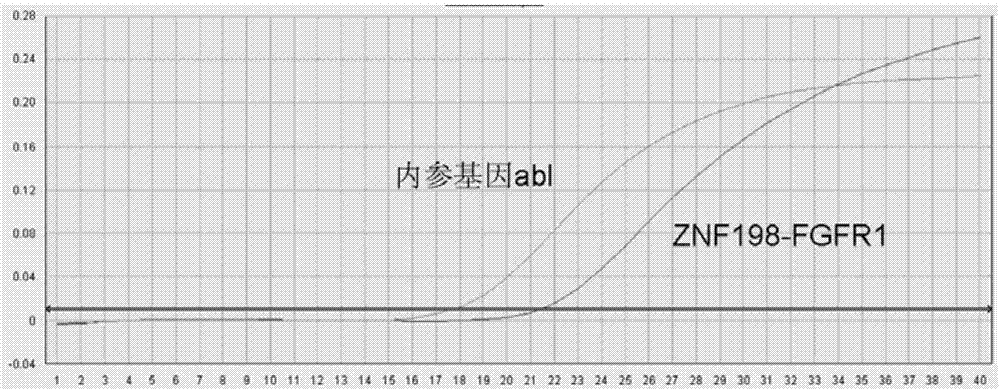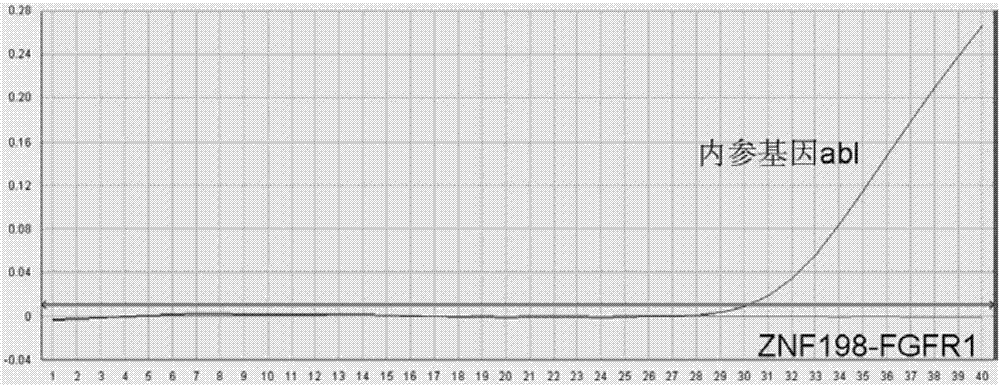Oligonucleotide, method and kit for detecting ZNF 198-FGFR1 fusion gene in sample
A ZNF198-FGFR1 and ZNF198-FGFR1-F technology, which is applied in the field of oligonucleotides and kits for detecting ZNF198-FGFR1 fusion genes in samples, can solve the problems of patients losing optimal treatment timing and lack of sufficient knowledge, etc. To achieve the effect of eliminating the need for conditional exploration, saving detection time, and improving experimental efficiency
- Summary
- Abstract
- Description
- Claims
- Application Information
AI Technical Summary
Problems solved by technology
Method used
Image
Examples
Embodiment 1
[0044] Oligonucleotides for detecting the ZNF198-FGFR1 fusion gene in the sample, the oligonucleotides include the upstream primer ZNF198-FGFR1-F for detecting the ZNF198-FGFR1 fusion gene, the downstream primer ZNF198-FGFR1-R and the probe ZNF198- FGFR1-Probe, its base sequence is:
[0045] ZNF198-FGFR1-F:TGCCTATCCCTGTGCCTG;
[0046] ZNF198-FGFR1-R:GAGTCCCACTGGAGGAGAGC;
[0047] ZNF198-FGFR1-Probe: FAM-TGATGGCCGAACCAGAAGAACCC-TAMRA.
[0048] Further, the oligonucleotide also includes an upstream primer abl-F, a downstream primer abl-R and a probe abl-Probe for detecting the abl internal reference gene, and its base sequence is:
[0049] abl-F:GATACGAAGGGAGGGTGTACCA;
[0050] abl-R:CTCGGCCAGGGTGTTGAA;
[0051] abl-Probe: FAM-GCTTCTGATGGCAAGCTCTACGTCTCCT-TAMRA.
[0052] A method for detecting ZNF198-FGFR1 fusion gene in a sample, the steps of which are:
[0053] (1) extract the RNA in the sample;
[0054] (2) Reverse transcribe the RNA extracted in (1) into cDNA;
[005...
Embodiment 2
[0076] Embodiment 2 detection steps
[0077] According to the oligonucleotide, method and kit in Example 1, detect the ZNF198-FGFR1 fusion gene in the sample (such as blood), the steps are as follows:
[0078] (1) Extract tissue RNA from blood:
[0079] Add 1ml of erythrocyte lysate to a clean 1.5ml centrifuge tube, take 0.5ml of anticoagulated blood and mix well, let it stand at room temperature for 10min; centrifuge at 5000rpm for 5min, discard the supernatant, and collect the cells at the bottom; add 0.5ml of erythrocyte lysate again, Centrifuge at 5000rpm for 5min, discard the supernatant, and collect the cells at the bottom; add 1ml TRIzol to the cells, pipette repeatedly until the precipitate is completely dissolved, and let stand at room temperature for 5min; add 0.2ml chloroform, shake evenly; centrifuge at 14000rpm 4°C for 10min, absorb the supernatant and transfer Transfer to another new centrifuge tube; add an equal volume of isopropanol, mix well up and down, let ...
Embodiment 3
[0089] Embodiment 3: Sensitivity test result
[0090] With the positive control substance in embodiment 1, about to contain the plasmid of ZNF198-FGFR1cDNA sequence, according to 10,10 2 ……..10 10 The dilution multiples of each step were used for gradient dilution, and the dilutions obtained by each gradient dilution were respectively used as cDNA templates, and fluorescent PCR amplification and detection were carried out according to the steps (3) to (7) in Example 2. Repeat the detection 10 times in the well, dilute 10 10 and 10 11 The test results are shown in Table 1 and Table 2 respectively:
[0091] Table 1 Dilution 10 10 When (concentration is 10copies / μL) detection results
[0092]
[0093]
[0094] Table 2 Dilution 10 11 When (concentration is 1copies / μL) detection results
[0095] Wells of 96-well plate
Ct(ZNF198-FGFR1)
A9
39.32
B9
39.94
C8
Undet.
C9
Undet.
D8
Undet.
D9
Undet.
E8...
PUM
 Login to View More
Login to View More Abstract
Description
Claims
Application Information
 Login to View More
Login to View More - R&D
- Intellectual Property
- Life Sciences
- Materials
- Tech Scout
- Unparalleled Data Quality
- Higher Quality Content
- 60% Fewer Hallucinations
Browse by: Latest US Patents, China's latest patents, Technical Efficacy Thesaurus, Application Domain, Technology Topic, Popular Technical Reports.
© 2025 PatSnap. All rights reserved.Legal|Privacy policy|Modern Slavery Act Transparency Statement|Sitemap|About US| Contact US: help@patsnap.com



